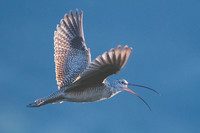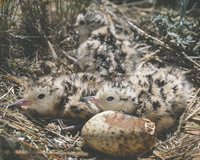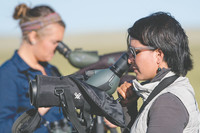Cloudy, 40° F
As researchers approached a nesting site of long-billed curlews in their dust-covered SUV, a male curlew was already mobbing them.
When threatened, curlews dive-bomb and screech at anything or …
This item is available in full to subscribers.
The Powell Tribune has expanded its online content. To continue reading, you will need to either log in to your subscriber account, or purchase a subscription.
If you are a current print subscriber, you can set up a free web account by clicking here.
If you already have a web account, but need to reset it, you can do so by clicking here.
If you would like to purchase a subscription click here.
Please log in to continue |
|





As researchers approached a nesting site of long-billed curlews in their dust-covered SUV, a male curlew was already mobbing them.
When threatened, curlews dive-bomb and screech at anything or anyone that approaches within 600 yards of their chicks.
“They’ll even mob your car,” said Madeline Voshell, a curlew research assistant.
Curlews nesting in the area are having great success despite numerous predators ranging from egg thieves like coyotes and ravens, to many raptors, said Voshell, in her second season on the Curlew Crew.
“We have 100 percent nest success in the [Big Horn] Basin this year,” Voshell said. “We suspect there have been some failed nests, but as far as the nests we’ve found, they have all been successful.”
The Curlew Crew is a team of scientists and research assistants who are studying the bird from its wintering grounds in Mexico to its important breeding grounds in the grasslands of midwest and western states in the U.S. The crew is led by Jay Carlisle, research director of the Intermountain Bird Observatory at Boise State University and associate research faculty member of the university’s Biological Sciences Department.
Voshell was at the wheel last week. In the passenger seat was Eugenia Senties, a research scientist from Vera Cruz, Mexico, who’s working on her doctorate. The two have been studying nesting success in the Big Horn Basin, on the Polecat Bench and, for the first time ever, in Oregon Basin.
“We’re trying to get a grasp on how many curlew are in the area,” Voshell said.
The researchers began drawing the ire of the male curlew when they were still 500 yards from the nest.
They reached the nest by foot just hours after the hatch; Voshell wasn’t surprised to find one of the four healthy chicks already fleeing at a fast pace to avoid the perceived threat. Like two cotton balls on tiny legs, the chick sprinted 10 yards and then hunkered down, hoping its natural camouflage hid it from the researcher. The chicks’ mother, with her 9-inch-long bill, stayed on the nest until Voshell was just feet from the hidden indentation on the ground in thick sagebrush.
The graceful mother didn’t go far. She flew to a vantage point atop a low-growing sagebrush and scolded Voshell. The male, with a relatively shorter bill, continued its air assault on the researcher as she removed an eggshell from the nest to take back to the lab for DNA testing.
The previous day, the researchers had attempted to check another nest, but found the chicks had scrambled more than 600 yards from the nest within a day of breaking out of their shells. Curlew eggs are camouflaged with mottled, earthtone colors. The chicks’ ability to flee just hours after hatching is an added defense mechanism against predators. It also makes it nearly impossible to watch their progress after hatching.
The species’ relentless mobbing is incredibly successful in keeping nests safe from all but one danger: humans. In recent weeks, the curlew crew has found nearly a dozen individuals downed by gunshot. The protected species, several of them carrying satellite transmitters installed in a painstaking process by the crew, are easy targets for irresponsible gun owners.
“Poaching is the number one source of mortality in a declining population,” Carlisle said.
Several of the birds shot wore $3,000 transmitters. To attach transmitters, scientists stake out known nesting areas — sometimes for days — waiting for the moment a pair has a full clutch. Then the team deploys a 60-foot long net across hard-to-navigate terrain to briefly capture curlews, quickly installing the transmitter after a series of tests.
Currently, seven out of 16 curlews with attached transmitters have been shot in Idaho project areas and another 10 without transmitters were also gunned down. Other species, including hawks, eagles and owls, have been found shot as well, Carlisle said.
Long-billed curlews share this habitat with a host of other critters. Voshell and Senties have watched swift fox, black bears, pronghorn, raptors like northern harriers and golden eagles and other bird species like lark buntings, mountain plovers, western meadowlarks and the comical horned lark for more than two months while studying the curlew. Many look at the sagebrush-covered high desert as a vast wasteland, but more than 350 vertebrate species have been recorded here.
Curlew are more likely to be poached in high use areas, Voshell said.
“It’s kind of a free-for-all, it seems like,” she said. “Ground nesting birds are always at risk to predators, but I can’t even begin to explain [poachers’] motivations.”
Voshell, from Delaware, came to Wyoming to work for the crew and fell in love with the region. Senties did her master’s thesis on hummingbirds and pollination, but was working on monitoring bird mortality at Mexican wind farms prior to landing the job with the crew. Both were excited to get the chance to study curlew.
“It’s important to find out how many curlews are in this area as well as the nesting success rate,” Voshell said.
The Big Horn Basin is considered an unusual area for curlews to thrive. Often thought of as a shore bird, curlews have made the desert area one of their more successful breeding habitats. Nesting success rates are typically much lower in other study areas, Carlisle said.
“We normally see a nesting success rate of about 25-40 percent,” he said.
But the researchers aren’t just studying the species’ reproduction and migration trends. They’re also studying the effects of their own intervention in the bird’s lives. The good news is that the work of the crew doesn’t seem to be adversely affecting individuals they’ve captured.
“We are seeing that the birds with transmitters are still having successful nests,” Senties said.
The study will end in the first week in July. Curlews will be migrating back to Mexico and southern California by the end of July. The females leave first, leaving the males behind to tend to the brood briefly before he follows with their young in tow.
“We only see the birds [in Mexico] in the winter, and probably just once in a lifetime,” Senties said.